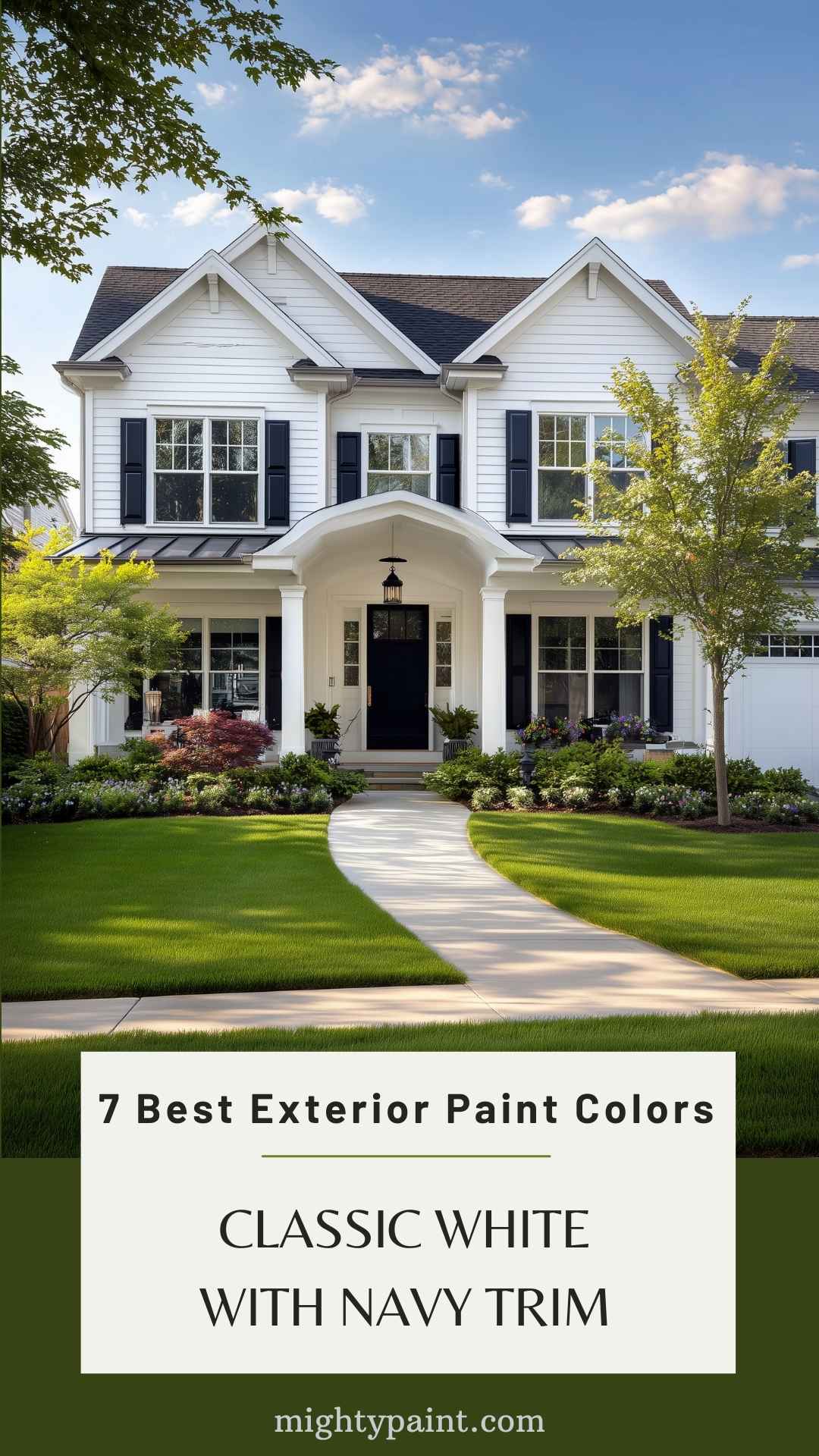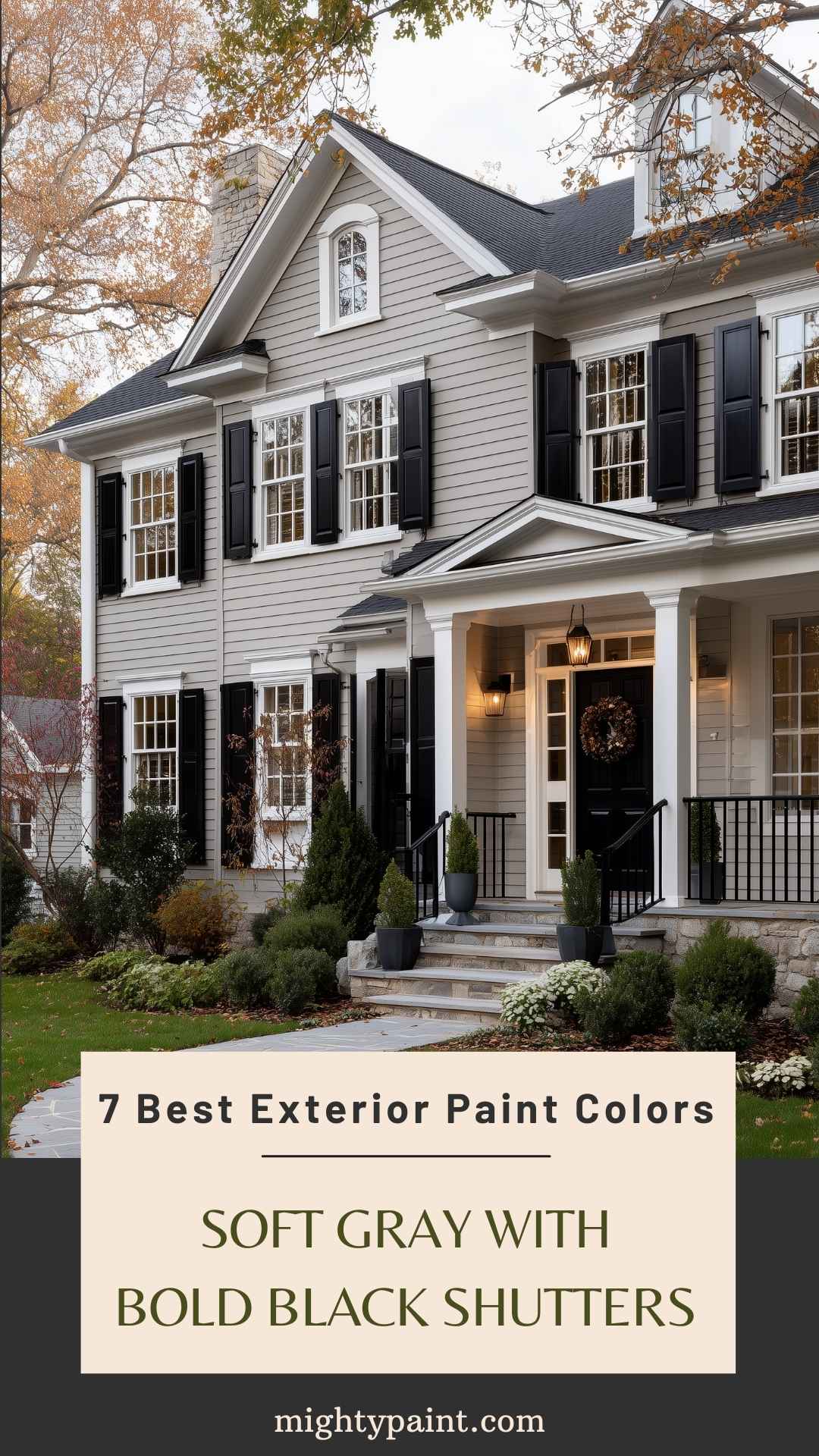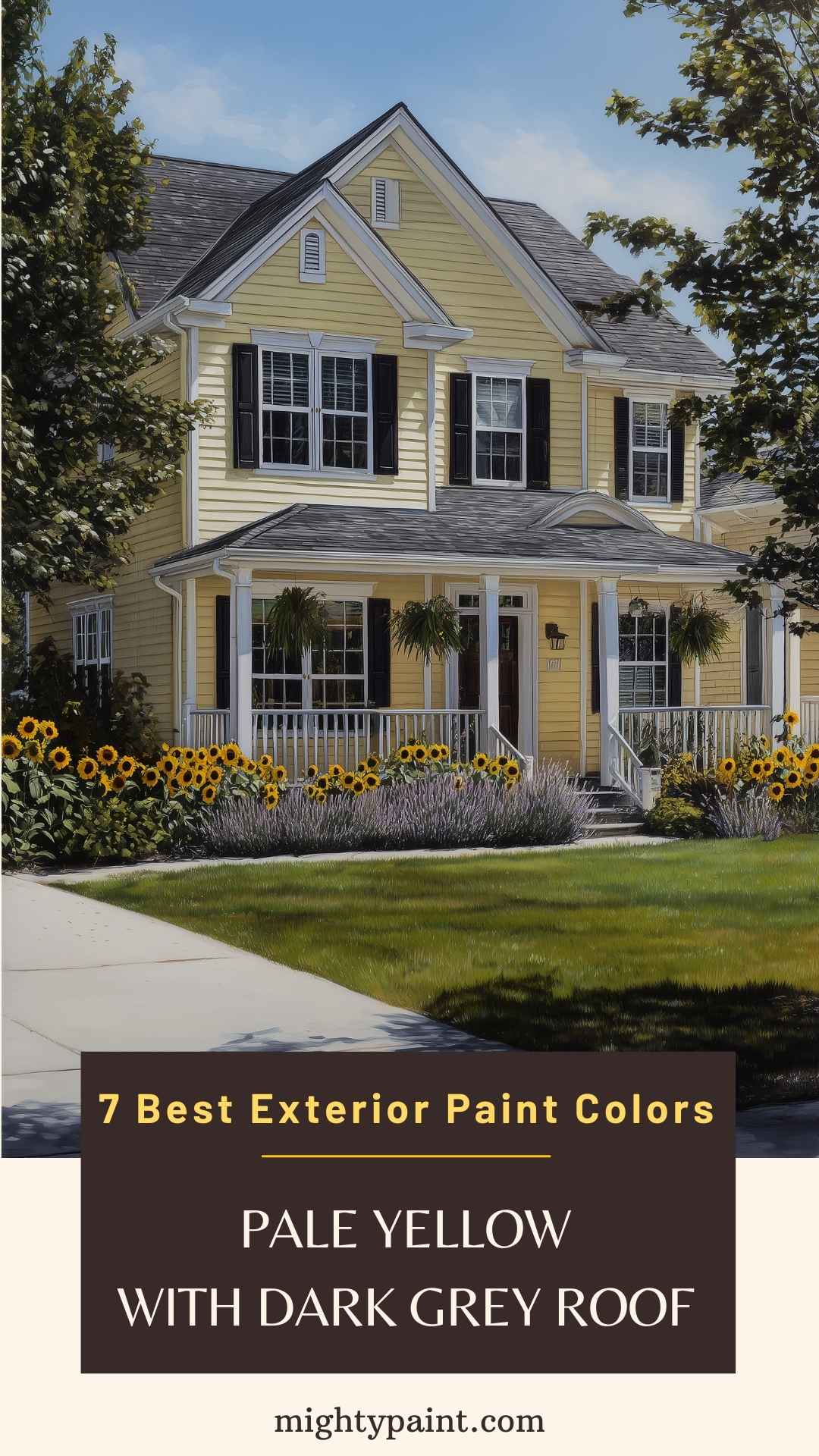7 Best Exterior House Paint Color Combinations to Boost Curb Appeal
Choosing the right color combination for the exterior of a house can significantly enhance its curb appeal and overall aesthetic. Picking the best colors isn’t just about what’s trendy; it’s about finding a look that suits the home’s architecture and the homeowner’s style.
By selecting the ideal color scheme, one can transform an ordinary house into a standout masterpiece.

A great exterior paint job can also increase the home’s value and attract potential buyers. It is essential to ensure that colors complement each other and highlight the property’s best features.
Whether it’s a bold, dramatic palette or a soft, subdued one, the right combination will have a lasting impression.
1. Classic White with Navy Trim

Imagine a home that stands out with a clean, fresh look. Classic white walls paired with navy trim create a timeless charm. The white provides a bright, welcoming base, while the navy trim adds depth and sophistication.
This combination works great on different house styles, from colonial to modern.
Navy trim around windows and doors gives a sharp, elegant outline. It highlights architectural features without overpowering the home’s natural beauty.
The contrast of white and navy creates a crisp, clean look. It can make your home more noticeable and appealing.
Using these colors can also increase curb appeal and potentially add value to the property. White reflects light, making the house appear larger and more open.
Adding navy trim can be a practical choice. Navy, being a dark color, hides dirt and imperfections better than lighter shades. This means less frequent cleaning and maintenance.
So, if you’re looking for a classic yet modern vibe, consider painting your house white with navy trim. It’s a choice that won’t go out of style and will keep your home looking fresh and elegant for years to come.
2. Earthy Brown with Cream Accents

Earthy brown paired with cream accents creates a warm and inviting exterior. Brown can give your home a natural and grounded feel. It is a versatile color that works well with many styles, from traditional to modern.
Cream accents add a touch of elegance and brightness. They can highlight architectural features like trim, window frames, and doors.
This combination is perfect for homes in wooded or rural settings, blending well with natural surroundings.
Using different shades of brown can add depth and interest to your home’s exterior. Rich chocolate brown or a lighter tan can both work beautifully.
Cream is a great choice for areas that you want to stand out. It softens the intensity of the brown and makes features pop without being too stark.
Consider adding cream-colored shutters, railings, or porch columns. These touches can balance the darker tones and make your home feel more balanced and cohesive.
Earthy brown and cream is a timeless combination that will keep your home looking stylish for years to come.
3. Soft Gray with Bold Black Shutters

Soft gray paint on a house exterior offers a clean and calming vibe. It’s a color that fits both modern and traditional homes well.
When you combine this gentle shade with bold black shutters, the result is striking. The black adds a strong contrast that brings out architectural details.
This color combo isn’t just about aesthetics. It’s practical too.
Gray hides dirt and imperfections while staying stylish. Black shutters, being darker, also don’t show dirt easily and add a touch of elegance.
Popular gray shades like Benjamin Moore’s Thunder or Stormy Sky can be paired with deep black shutters to create a timeless look.
Whether your house is in the city or the countryside, this combination works beautifully to enhance curb appeal.
Adding black shutters also means you can play with smaller details like door frames or railings in black or matching dark tones. This creates a cohesive look.
It’s a simple way to make your home stand out without being too bold. The soft gray and bold black can truly transform the appearance of any home.
4. Warm Beige with Deep Red Door

A warm beige exterior paired with a deep red door can create an inviting and classic look for any home. Beige provides a neutral, calming base that complements many architectural styles. It’s a versatile choice that works particularly well for craftsman and colonial homes.
Adding a deep red door to this color scheme packs a punch. The red contrasts beautifully with beige, creating a focal point that draws the eye.
Red doors are known for symbolizing positive energy and welcoming vibes. They make the entrance look both impressive and approachable.
For trim options, white or cream can accentuate the warm beige walls. This combination highlights roof peaks and windows. It adds a clean, crisp touch, ensuring the house looks fresh and bright.
Consider landscaping to enhance this color scheme. Greenery, such as shrubs and colorful flowers, will blend well with the warm hues of beige and the bold red door. It creates an overall harmonious and appealing look for the exterior.
Lastly, don’t forget about lighting. Warm-toned exterior lights will complement the beige and red. They can make your home look cozy and inviting in the evening, enhancing curb appeal even further.
5. Light Blue with White Trims

Light blue paired with white trims brings out a clean and refreshing look to any home. This combination is popular for coastal and traditional homes, as it evokes a sense of calm and serenity.
Light blue is a versatile color. It can be paired beautifully with various shades of white.
For instance, Ballet White (OC-9) by Benjamin Moore offers a warm touch while still maintaining brightness.
White trims highlight architectural features and add a crisp contrast to the light blue.
This setup is ideal for homes with lots of windows, as the white trim frames them nicely and makes them stand out.

Using a light blue shade like Canyon Blue by PPG Paints can make the house stand out. It’s also visually appealing when paired with white columns around the front steps, creating an inviting entrance.
For a softer feel, consider using Sherwin-Williams Shoji White for the trims. Its subtle warmth complements the coolness of the light blue.
The combination of light blue with white trims suits various home styles, from contemporary designs to classic Victorian houses. This duo adds charm and elegance while keeping the home exterior looking fresh and modern at the same time.
6. Dark Green with Gold Touches

Dark green with gold accents is a classic combination. It blends the richness of green with the luxury of gold. This pairing can give any home an elegant and timeless look.
Using dark green as the primary color creates a strong, earthy vibe. It connects the home to nature, providing a calm and grounded feel. It’s also versatile and works well with various architectural styles.
Adding gold touches elevates the overall aesthetic.

Gold can be used for door handles, light fixtures, or window trims. These elements add a touch of brightness and sophistication.
This color combination works well in different settings. In urban areas, it stands out without being flashy. In rural settings, it complements the natural surroundings beautifully.
Choosing the right shade of dark green is crucial. Behr Fig Tree and Sherwin Williams Sage Green Light are excellent choices. These shades provide depth and look stunning with gold accents.
Remember to balance the colors.
Don’t overwhelm the green with too much gold. The gold should highlight features and create focal points. This balance ensures a harmonious look that’s pleasing to the eye.
7. Pale Yellow with Dark Grey Roof

Pale yellow exteriors create a bright and cheerful look for any home. This soft color pairs beautifully with a dark grey roof, adding contrast and sophistication.
Imagine driving up to a house painted in a light, sunlit yellow. It feels warm and inviting right from the start. The dark grey roof adds a modern touch, balancing the vividness of the yellow.
This combination works well in various settings. The grey color tones down the brightness just enough to make the house look elegant rather than overwhelming.
Adding white trim can further enhance this look. The crisp white acts as a neutral divider between the pale yellow walls and the dark grey roof. White columns around the porch or white shutters can make the entire front more appealing.
For the front door, consider colors like a deeper yellow, navy blue, or even a bright red. These colors will pop against the pale yellow walls and dark roof, drawing attention to the entryway.
Accentuate your garden with flowers that complement the house colors. Sunflowers, white roses, or lavender can tie the entire aesthetic together, making your home look cohesive and inviting.
Understanding Color Theory
Color theory helps you pick the right combinations for your home’s exterior. It involves the color wheel, warm and cool colors, and how colors interact.
The Color Wheel Basics
The color wheel is the foundation of color theory. It visually represents how colors relate to each other. There are three primary colors: red, blue, and yellow. These colors mix to create secondary colors: orange, green, and purple. Then, mixing primary and secondary colors yields tertiary colors like red-orange or blue-green.
It’s essential to understand complementary colors. These are opposite each other on the wheel, like blue and orange. They create contrast and make each other stand out. Analogous colors, like blue, green, and teal, sit next to each other on the wheel. They offer a harmonious and soothing look.
Warm vs Cool Colors
Warm colors include reds, oranges, and yellows. These hues evoke energy, warmth, and excitement. They can make a home seem more inviting and cozy. For example, a warm red front door can be very welcoming.
Cool colors consist of blues, greens, and purples. They bring calmness and relaxation. Cool tones are perfect for creating a serene and peaceful home exterior. Think of a cool blue or green house by the water, giving off a tranquil vibe.
Mixing warm and cool colors can balance your home’s exterior. For instance, you might use a cool blue as the main color and a warm red for accents to create contrast and interest.
Complementary Color Combinations
Choosing complementary colors for your house exterior can create a striking and balanced look. These combinations often utilize opposite colors on the color wheel to achieve harmony and visual interest.
Why Choose Complementary Colors?
Complementary colors are great because they create a strong contrast while still looking harmonious. This type of color scheme can make certain features of your home pop and grab attention.
Using complementary colors can make the architectural elements of your house stand out. For example, if you have dark blue siding, pairing it with a yellow door can create a noticeable and appealing contrast.
Complementary color combinations are also versatile and work well with different styles, whether your home is modern or traditional. They add vibrancy without overwhelming the eye.
Examples of Stunning Combinations
Here are a few examples of how complementary colors can be used effectively:
- Blue and Yellow: Dark blue siding with a bright yellow door. This combination brings vibrancy and highlights features like windows and doors.
- Red and Green: A red house with green trim can feel festive without feeling like holiday decor. This works especially well with homes that have lots of natural wood.
- Purple and Yellow: Light purple siding paired with yellow accents can give a whimsical and cheerful look, adding charm to cottage-style homes.
Frequently Asked Questions
Here are some common questions and answers to help you decide on the best exterior house paint color combinations.
How can I choose a timeless color palette for my home’s exterior that will stand the test of time?
Choosing a timeless color palette involves selecting colors that remain stylish over the years. Classic combinations like white with navy trim or earthy brown with cream accents are always in style. Stick to neutral tones with complementary trims for long-lasting appeal.
What are the pros and cons of using a bold color scheme for my house exterior?
Bold color schemes, like soft gray with bold black shutters, can make your home stand out. They add personality and curb appeal. On the downside, bold colors may need more frequent touch-ups and might not be appealing to everyone, especially if you’re planning to sell your home soon.
Can you suggest any popular exterior paint colors that are trending in 2024?
In 2024, popular exterior paint colors include Newburyport Blue (HC-155) by Benjamin Moore and Tricorn Black (SW 6258) by Sherwin-Williams. These colors are chosen for their rich tones and versatility, adding modern elegance to various home styles.
What are some color combinations recommended by professional painters for house exteriors?
Professional painters often recommend combinations like warm beige with a deep red door for a welcoming feel or light blue with white trims for a fresh and clean look. These combinations provide both contrast and balance, enhancing the architectural details of your home.
How can I use an exterior house color palette generator to decide on my paint colors?
Using an exterior house color palette generator can be very helpful. Input photos of your home and experiment with different color schemes. These tools allow for visualization of various combinations before making a decision, ensuring that you choose colors you love.
What are some effective color strategies for enhancing the curb appeal of my home?
To enhance curb appeal, use contrast to highlight architectural features. For example, a soft gray base with bold black shutters can make windows pop. White trims around doors and windows add elegance and clean lines, drawing attention to the beauty of your home’s design.
